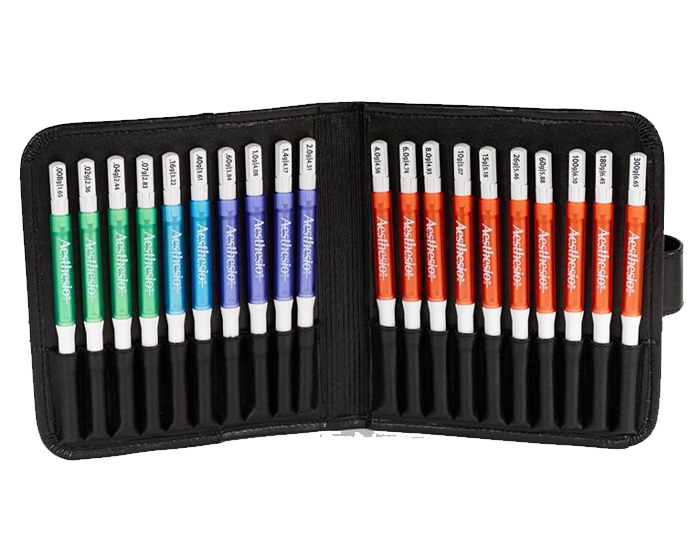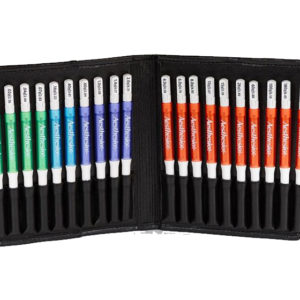Aesthesio®, Precise Tactile Sensory Evaluator 20 piece Kit
Touch pressure threshold testing involves the use of nylon monofilaments of
different lengths and increasing diameters. These monofilaments provide controlled
gradients of force to the mechanoreceptors in the skin and can thus be used to
determine pressure detection thresholds. The advantage of monofilament testing is
that it provides quantified and repeatable information about a patient’s detection of
touch. The pattern of sensibility loss reflected by the monofilament testing helps to
identify pathology.
Features
Description
Aesthesio® Precision Tactile Sensory Evaluators (Semmes-Weinstein Monofilaments)
provide a noninvasive evaluation of cutaneous sensation levels throughout the
body with results that are objective and repeatable. Using Aesthesio® Precision
Tactile Sensory Evaluators is indicated in diagnoses including nerve compression
syndromes, peripheral neuropathy, thermal injuries and postoperative nerve repair.
The Aesthesio® Precision Tactile Sensory Evaluator consists of a standardized
set of nylon filaments, all of varying length and diameter. The force at which a
monofilament bends is proportional to its diameter, and inversely proportional to its
length. Aesthesio® Precision Tactile Sensory Evaluators are selected and labeled so as
to give a linear scale of perceived intensity (a logarithmic scale is applied.)

Instructions for Threshold Testing in Humans

Sensibility testing should be conducted in a quiet environment, where the patient is comfortable and relaxed. Common test points are outlined in the illustrations below. For detailed and comprehensive test protocols, please reference the following sources: Bell-Krotoski JA: “Sensibility Testing: History, Instrumentation and Clinical Procedures”, Rehabilitation of the Hand and Upper Extremity, Volume 1, Elsevier Mos by 2011, Chapter 11, Pages 132-145. www.hrsa.gov/hansensdisease/leap/

Use of Aesthesio® Precision Tactile Sensory Evaluator Kit with Animals

The standard procedure for the Aesthesio® Precision Tactile Sensory Evaluator when used with humans is to ask the subject to report if they have been touched. Since animals cannot verbalize whether they have been lightly touched, reflex reactions can be used in place of a verbal report of sensation. The “Paw Withdrawal Reflex” is a useful one. When a filament of detectable presence is applied, the paw will immediately withdraw, and inflammation will increase the withdrawal reflex.
Proper Storage and Handling:
Aesthesio® Precision Tactile Sensory Evaluators are precision instruments.
Care should be taken at all times to protect the integrity of the nylon filament.
The filament may be cleaned with a mild instrument disinfectant (e.g. Isopropyl
Alcohol or similar. Avoid chlorine-based disinfectants.) Make sure the
monofilaments are thoroughly dry before reusing.
Substantially bent or kinked monofilaments must not be used for testing
and should be discarded and replaced. DanMic Global, LLC item numbers
can be found in the chart to the right (3rd column), and refers to the
individual evaluators.
Store the evaluators at room temperature and humidity. Do not store in or
expose to direct sunlight.

Specs
FAQ's
Related Products
What we are about
Xperiment Girl’s past was shrouded in mystery until now. Xperiment Girl was originally the international respected Dr. Gene Knockout researcher extraordinaire, a living legend working out of her hidden Nerve Center at IITC. For most of her career, Xperiment Girl worked with inferior equipment resulting in bad data.
Teaching the fine art of mastering and measuring accurately tail cuff blood pressure on mice, rats and all other animals, Xperiment Girl in turn intrigued by pain and how she could assist in superior equipment in the field of pain tolerance, fascination/became obsessed with solving poor test data from inferior equipment. Continue reading...
- IITC Inc./Life Science
- 23924 Victory Blvd.
- Woodland Hills, CA 91367 US
- 818-710-8843



